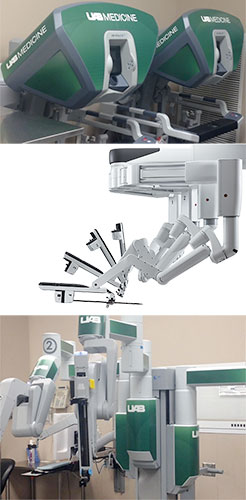 UAB has four da Vinci surgical robots and is about to take delivery of a fifth
UAB has four da Vinci surgical robots and is about to take delivery of a fifth
Surgeons and administrators from hospitals in 26 states and several foreign countries will attend the 2016 Academic Session on robotic-assisted surgery at the University of Alabama at Birmingham. The session, to be held Feb. 19-20, is co-sponsored by Intuitive Surgical, developers of the da Vinci surgical system, the most common surgical robots in use in the United States.
The event features presentations from leading surgeons in the field of robotic-assisted surgery from UAB and around the nation, and will offer three live-streamed surgical case observations performed by UAB surgeons. Attendees will be able to view a video feed of the surgeries, and interact with members of the surgical team.
“The conference brings together some of the most accomplished surgeons using robotics today,” said Herbert Chen, M.D., professor and chair of the UAB Department of Surgery. “This unique educational forum will spark discussion on how best practices can improve patient outcomes, and how to deftly combine training, education and patient care in robotic-assisted surgery.”
Nearly 200 surgeons and hospital administrators are scheduled to attend the conference, representing some of the pre-eminent hospitals in the country, including Johns Hopkins, the Mayo Clinic, MD Anderson Cancer Center and Emory University.
With more than 7,000 procedures performed, UAB boasts the eighth-largest program in the nation among academic medical centers. Thirty-three active UAB surgeons have been trained in the use of the da Vinci systems. UAB does about 1,000 surgeries each year with the da Vinci systems, about triple the average of Alabama hospitals.
UAB has three of the da Vinci Si surgical systems, a next-generation robot that retains and builds on the core technology at the heart of the existing da Vinci and da Vinci S systems. UAB also has one of the newest Xi systems and will receive delivery of another this month. Da Vinci Xi is the next frontier for minimally invasive surgery.
UAB physicians in eight surgical disciplines utilize robotic surgery, including cardiac, thoracic, liver, urologic, gynecologic, colorectal, oncologic and general surgery.
“UAB is poised to be the world leader in teaching and performing robotic-assisted surgery,” Chen said. “There are very few other academic medical centers that have the breadth and range of use of robotic surgery. We have also pioneered the training of surgical residents in robotic-assisted surgery.”
“We have a robust training program in place at UAB, as more than 1,000 physicians from around the world have come to UAB to learn about robotic surgery,” said Robert Cerfolio, M.D., professor and chief of Thoracic Surgery. Cerfolio is performing one of the demonstration surgeries at the conference. “We’ve established standards and guidelines for training residents, fellows and attending physicians in robotic-assisted surgery.”
Along with Cerfolio, Jamie Cannon, M.D., associate professor and interim director of the UAB Division of Gastrointestinal Surgery, and John Porterfield Jr., M.D., associate professor of surgery, will perform demonstration surgeries at the conference.
“One of the most exciting aspects of the academic session will be the demonstration surgeries,” Cannon said. “The live-streamed surgeries will provide an unparalleled opportunity for attendees to get a firsthand look at how robotic-assisted surgery can provide outstanding patient care in an efficient manner.”
“At UAB, we’ve strived to incorporate robotic surgery into as many disciplines as possible, as this technology allows surgeons to perform many types of complex procedures with unprecedented control and precision,” Porterfield said. “Robotic-assisted surgery usually leads to shorter hospital stays, faster recovery and minimized complications and functions as a safe platform for teaching surgical residents.”
“We are constantly pushing the envelope to increase the utilization and improve the implementation of minimally invasive surgery for patients,” said Jeffrey Nix, M.D., assistant professor in the Department of Urology. “From a cancer perspective, we are one of the highest-volume robotic cystectomy centers in the Southeast, and we were part of a group that pioneered the implementation of advanced imaging for the diagnosis of prostate cancer.”
Speakers at the Academic Session include:
- Herbert Chen, M.D., professor and chair of the UAB Department of Surgery; The UAB da Vinci experience
- Michael Stifelman, M.D., director, Robotic Surgery Center, New York University School of Medicine; How to build a multidisciplinary da Vinci surgery program in academics
- Larry Kaiser, M.D., CEO of Temple University Health Center; A business case for da Vinci surgery
- Robert J. Cerfolio, M.D., professor and chief of Thoracic Surgery, UAB, and Inderpal S. Sarkaria, M.D., director of Thoracic Robotic Surgery, University of Pittsburgh Medical Center; Teaching da Vinci thoracic surgery while maintaining quality, efficiency, patient outcomes and profitability
- John Martinie, M.D., associate professor of surgery, Carolinas Medical Center, and Herbert J. Zeh, III, M.D., professor and chief of the Division of GI Surgical Oncology, University of Pittsburgh; Data showing advantages of da Vinci surgical oncologic surgery
- Jamie Cannon, M.D., associate professor and interim director of the UAB Division of Gastrointestinal Surgery, and Julio Garcia-Aguilar, M.D., Ph.D., chief of the colorectal service, Memorial Sloan Kettering Cancer Center; Data showing advantages of da Vinci colorectal surgery
- John R. Porterfield Jr. M.D., associate professor of surgery and director, General Surgery Residency Program, UAB; Training your general surgical residents in da Vinci surgery
- Ajita Prabhu, M.D., assistant professor of surgery and director of Surgical Education, University Hospitals Case Medical Center; Data showing advantages of da Vinci hernia surgery